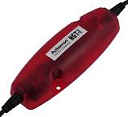Setting up Instruments
TimeZero can be connected to real time instruments such as AIS receiver, DSC Radio or Weather Station (Wind, Temperature, and Pressure). If the software is using dynamic positioning (instead of manual fix position), GPS and Heading sensors must be connected.
Instruments can be connected to the PC through an NMEA0183 interface (serial port), through the Network or through NMEA2000 (using the Actisense NGT-1 USB Gateway).
Note: GPS and Heading instruments are not required by TimeZero. A fix position (lat/lon) and orientation can be entered from the Initial Setup and Radar Options. If GPS and Heading instruments are connected and configured, it is possible to use the position and orientation from the sensor by pressing the "Insert Position from Sensor" button available in the same pages or switch the software operation mode to dynamic position and orientation (refer to Fixed & Dynamic Position for more information).
-
Serial Port: In most cases, connecting an NMEA0183 instrument to a computer is straightforward, and is accomplished by simply connecting the serial cable supplied by the instrument manufacturer to the serial port on the PC. The serial port is a nine-pin male port on the back of the computer often identified by an IO or COM symbol.

-
Serial to USB adapter: Newer computers may not include a serial port. One can be added by using a serial-to-USB adapter, which can be obtained from any marine dealer. A serial-to-USB adapter will create a "virtual COM port" on your computer that can be viewed in the "COM and Ports" section of the Device Manager.

IMPORTANT: Make sure to install the USB adapter drivers BEFORE connecting the USB cable of the adapter to the computer! -
Actisense NGT-1-USB (old style) & NGX-1-USB (new Style): The Actisense NGT-1-USB and NGX-1-USB are USB to NMEA2000 adapters which allow TimeZero to receive data from a NMEA2000 bus.

IMPORTANT: Make sure to install the USB adapter drivers BEFORE connecting the Actisense adapter to the computer! Also note that TimeZero is NOT compatible with the Actisense NGT-1-ISO or NGX-1-ISO that uses a serial connection. -
Ethernet: Sensors (such as Furuno Radar, Furuno Ethernet AIS Receiver, Serial to Ethernet adapter etc...) can be connected to the computer using a local area connection (100Base-T, Fiber Optic) or via high speed Line of Sight WIFI (30Mbps). Regular NMEA0183 (such as AIS or ARPA data) can also be transmitted over Ethernet (from a serial to Ethernet adapter) using UDP or TCP.

Tips: For more information about installing Radar and Camera please refer to the Installation chapter.
Automatic Instrument Configuration
TimeZero can locate most instruments (such as AIS or Wind Sensor) connected to the computer automatically. To use this feature, start TimeZero . Next, launch the Automatic Configuration Wizard:
-
Click on the "TimeZero" Button located on the top left of the screen
-
Click on "Connection Wizard"
-
Select the "Automatic Ports Configuration"; and then, click "Next"
-
Follow the on-screen instructions
Tips: For more information about connecting instruments, please refer to the Connection Wizard Chapter.
Default Reference Position
A default Reference Position needs to be setup from the Initial Setup Options. This is the position that will be used by default to center the chart on the screen. This position can be entered manually (by entering a lat/lon) or automatically (if a GPS sensor is connected and configured in the Connection Wizard) by pressing the "Insert Position from Sensor" or by switching the mode to Dynamic Position.
Tips: You can copy the coordinate of any point on the chart by right clicking on the chart while pressing the CTRL key down. Select "Copy Position". Then open the Initial Setup Options, click inside the position box of the "Default Reference Position" and press CTRL-V to paste the position.
Note: The Default Reference Position and Radar Position can be set to two different locations. The Radar Position and Orientation is adjusted from the Radar Options.